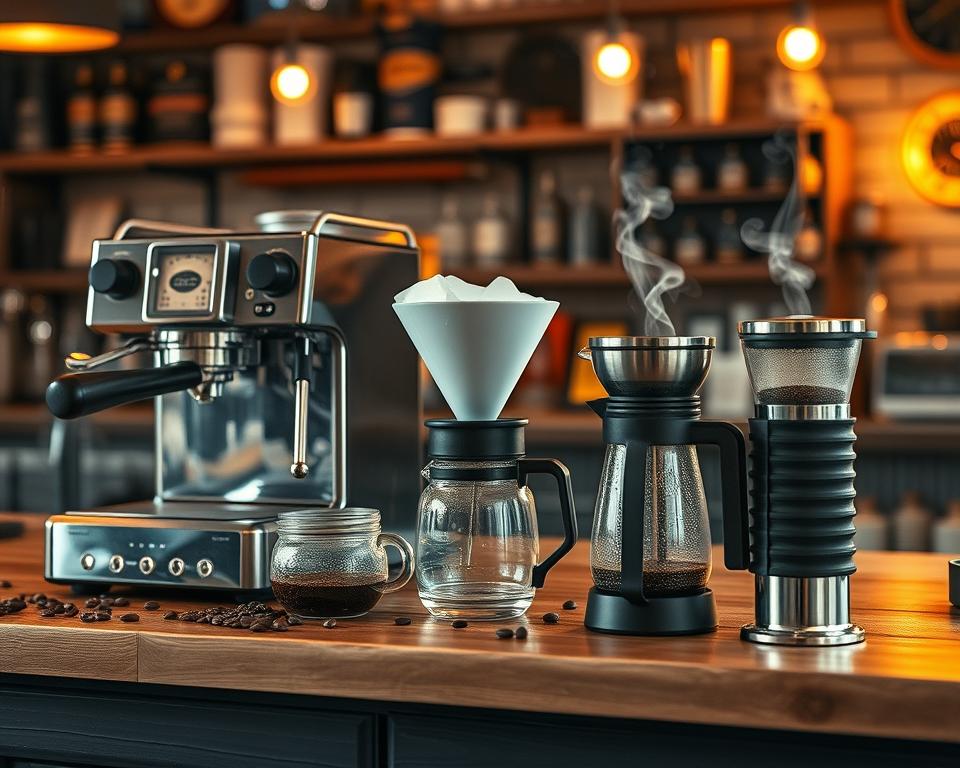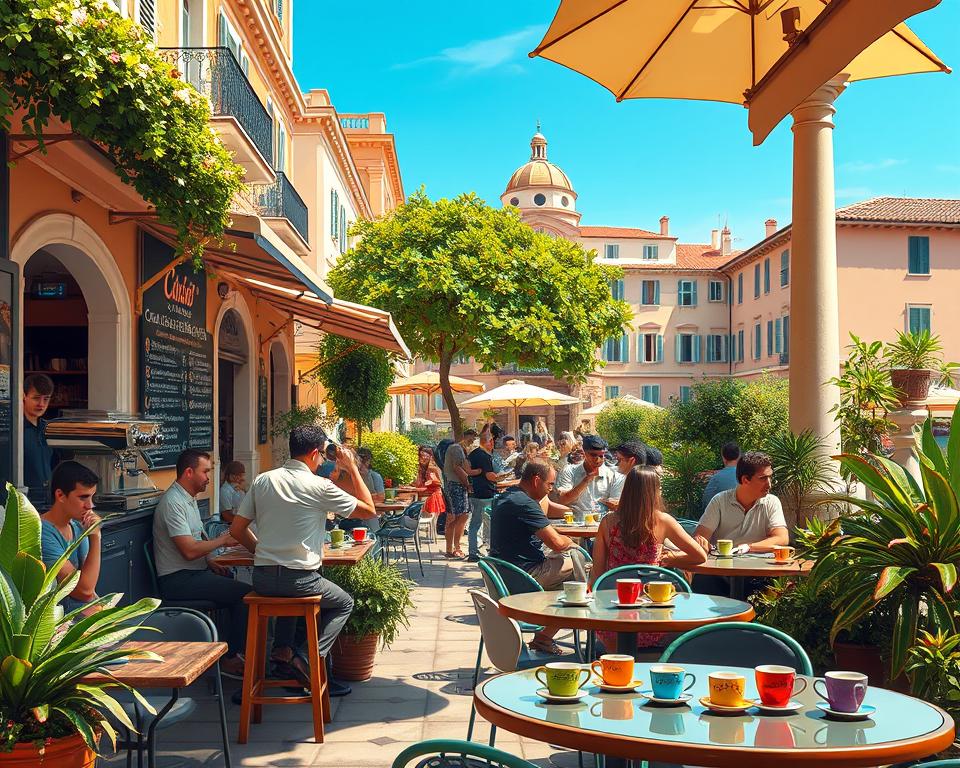Espresso is a key part of Italian coffee culture. It has a long history that started in the late 1800s. Angelo Moriondo created the first espresso machine in 1884. This invention changed how people made coffee by using separate controls for water and steam.
The early 1900s brought more advancements. Luigi Bezzera made the first commercial espresso machine in 1901. This cut down on brewing time. Desiderio Pavoni then helped make espresso more popular. He showed it off at the Milan International Fair in 1906. These changes made it possible to brew coffee in a way that kept and improved the beans’ flavors using high pressure.
The espresso machine continued to evolve. In the 1940s, Achille Gaggia introduced a lever-based system. This system made the crema thicker and richer, which coffee lovers enjoy. With each new development, espresso became more than a drink. It became a vital part of everyday life and social events, from Italy to coffee shops all over the world.
Introduction to Espresso Culture
Exploring espresso culture uncovers a deep coffee tradition in Italian life. The idea of espresso comes from ‘pressed out’ coffee making, using high pressure for quick, personal brews. Whether in a lively café or a quiet kitchen, espresso offers a tasty, energizing break.

The crema caffè is known for its creamy top. It gained fame in the 1940s through Achille Gaggia. His work on lever machines made a beloved crema. This innovation shaped espresso’s look and feel and advanced coffee tech.
Espresso is a key part of Italian culture, beyond just being a drink. It’s central to morning and afternoon breaks, shared with friends or coworkers. With 1-2 ounces per serving, it packs about 212 mg of caffeine per 100 g, giving a quick energy lift.
Espresso-based drinks like cappuccino, caffè latte, macchiato, and lungo each add their own touch to the tradition. The progress of espresso machines from Angelo Moriondo’s 1884 patent to today reflects ongoing innovation. This has shaped the espresso culture we know.
Espresso culture is a tribute to coffee art and science. From the first inventions to current brewing methods, espresso’s story highlights a global love for this strong, small beverage.
Early Inventions and Innovations in Espresso Machines
Espresso culture has a deep history, thanks to early pioneers. These key figures changed coffee brewing with their inventions. Their innovations impact us even today.
Angelo Moriondo’s First Prototype
In 1884, Angelo Moriondo patented the first espresso machine prototype in Turin, Italy. His invention used steam pressure for quick coffee brewing. It changed how we prepare coffee. Moriondo didn’t sell his invention, but it paved the way for future coffee machines.
Luigi Bezzera and the First Commercial Espresso Machine
Luigi Bezzera advanced Moriondo’s idea even further. In 1901, he patented an improved espresso machine. It brewed coffee under higher pressure, making the coffee better. This was a big moment for commercial espresso innovation. His machine was shown at the 1906 Milan International Fair, thanks to Desiderio Pavoni.

Desiderio Pavoni’s Contributions
Desiderio Pavoni saw potential in Bezzera’s design and got the patent. By 1905, he had introduced the first mass-produced espresso machine. It had a pressure release valve, a new standard. His work at the 1906 Milan Fair showed the world the efficiency and appeal of these machines. He highlighted Italian espresso craftsmanship globally.
The work of these early innovators led us from traditional brewing to modern espresso machines. Thanks to them, espresso culture is what it is today.
Espresso Culture in Italy
Espresso culture in Italy showcases the country’s deep coffee history and its evolution. The journey from busy pre-war espresso bars to today’s social centers is amazing. This rich tradition shows how special the drink is in Italy.
The Rise of Espresso Bars
Espresso bars popped up in cities like Turin, Rome, and Milan. They became key spots where folks from every background would gather. These places weren’t just about coffee; they were community centers for chat and friendship.
The idea behind these bars was more than serving a drink. It was about creating a spot for meaningful talks and connecting with others. It showed how a simple espresso could bring people together.
Espresso Post-World War II
After the war, espresso saw major improvements with new machines. Achille Gaggia introduced a lever system that made espresso even better. The “crema” on top became a sign of quality.
These enhancements made espresso bars more popular in Italy. Italian immigrants took espresso culture across the world. Thus, espresso became a global symbol of Italian heritage.
Espresso’s Role in Daily Italian Life
Espresso is key in Italian life, marking both tradition and social bonding. Italians usually drink their espresso quickly at the bar. They cherish its scent before enjoying the taste in a few sips.
With options like caffè ristretto, caffè lungo, and caffè macchiato, there’s something for everyone. These choices reflect the deep connection Italians have with their espresso.
The Origins of Espresso Culture
The history of espresso culture is deeply linked to Italy’s coffee trends in the late 19th century. Back then, the country was experiencing rapid industrial growth. This sparked a demand for faster coffee preparation, leading to the innovation of espresso machines. Angelo Moriondo’s invention in Turin in 1884 kicked off this new era.
As this culture grew, coffee bars started opening in Italian cities like Turin, Milan, and Rome. These spots became lively centers of social life. People would gather there to chat and soak in the bustling atmosphere.
Historical Context of Late 19th Century Italy
The late 1800s marked a big change for Italy. Industrial growth meant people wanted things faster, including their coffee. This triggered advancements in coffee brewing, with Angelo Moriondo leading the charge in 1884. His prototype was crucial, paving the way for the espresso machines we know today.
The Evolution of Espresso Over Time
Espresso technology didn’t stop with Moriondo. Luigi Bezzera and Desiderio Pavoni later made key improvements. By the early 20th century, espresso machines were common in Italian coffee bars. These places were essential in making espresso the popular drink it is today.
In 1948, the Gaggia machine further revolutionized espresso, winning over more fans post-World War II.
Espresso also became popular outside Italy, in countries like France and Spain. In the mid-20th century, immigrants introduced espresso bars to the United States. New York and San Francisco got their first taste of these vibrant social spots. Major chains like Starbucks pushed espresso onto the American scene in the 1980s and 1990s. Now, these bars are not just for quick coffee; they are places where communities come together worldwide.
Thinking about espresso’s history, its impact is undeniable. Baristas are now seen as artists, impressing not just with taste but also with visuals like latte art. Espresso’s strong flavor and quick prep time, along with the rise of Italian coffee bars, have made it a lasting cultural icon. For more insights into how coffee influences our lives, check out this article on coffee in intermittent fasting.
How Does Understanding the Origins of Espresso Culture Help in Choosing the Right Espresso Machine for Beginners?
Understanding the origins of espresso culture enhances the coffee experience. By appreciating its rich history, beginners can make informed choices when selecting equipment. This knowledge empowers you to explore beginnerfriendly espresso machines for home use, ensuring you choose a model that meets your brewing preferences and enhances your journey into espresso.
Spread of Espresso to Europe
Espresso quickly took off in Italy before spreading across Europe. Coffee lovers in France and Spain soon embraced these charming espresso spots. These bars meshed well with Europe’s coffee scene, becoming key social spots.
In Paris and Barcelona, cafes started using new espresso machines. Innovators like Francesco Illy contributed to these advancements. The “piston lever type” machine created the famous espresso crema, a hit among cafe visitors.
By 1961, the electric pump espresso machine was all the rage. It was beloved in European cafes for its consistent and efficient brews.
Espresso’s charm reached beyond big cities, from Berlin to London. The bars enhanced local coffee cultures. It was about more than just coffee; it was the joy of a well-made espresso. Espresso’s ability to fit into various cultures made it a European favorite.
FAQ
What is the history behind the origins of espresso?
Espresso comes from Italy, with a story that starts in the late 1800s. Angelo Moriondo got a patent for the first Italian coffee machine in 1884. Luigi Bezzera and Desiderio Pavoni then improved it, making it ready for shops. Their work led to a strong coffee known for its crema.
What is the significance of crema in espresso?
Introduced in the 1940s by Achille Gaggia, crema is the creamy layer on espresso. This layer forms from brewing coffee at high pressure. It is a sign of a good espresso.
Who was Angelo Moriondo, and what was his contribution to espresso machines?
Angelo Moriondo, from Italy, was the first to invent an espresso machine’s prototype. In 1884, in Turin, he patented his invention focusing on steam and water. This was the start of modern espresso machines.
How did Luigi Bezzera contribute to the commercial espresso machine?
Luigi Bezzera improved Moriondo’s initial design, creating the first machine for commercial use. This allowed for quicker brewing in cafes, changing coffee-making.
What role did Desiderio Pavoni play in the rise of espresso machines?
Desiderio Pavoni saw how Bezzera’s machine could be a hit and started producing it massively. He showed it at the 1906 Milan Fair. This introduced high-pressure espresso machines, changing how we drink coffee.
How did espresso bars become central to Italian social life?
Espresso bars popped up in cities like Turin and Milan, becoming key social spots. They offered quick and personalized coffee service. After World War II, these became part of Italy’s social tradition.
How did espresso culture change after World War II?
After the war, espresso machines got better, thanks to Gaggia’s lever system. Espresso bars grew, making the drink a key part of Italian lifestyle.
What is the role of espresso in daily Italian life?
For many Italians, espresso is a must-have daily drink. It’s quick, boosts energy, and comes with chats. It’s both a treat and a vital part of gatherings, showing its importance in Italy.
How did industrialization affect the development of espresso?
As Italy’s industry grew, so did the need for faster coffee making. Inventors like Moriondo created efficient machines. This changed coffee culture to match the faster life.
How has the technology behind espresso machines evolved over time?
Espresso machines started with separate steam and water control. Over time, they’ve seen lots of changes. Now, they use high-pressure brewing and have become very advanced.
How did espresso culture expand beyond Italy?
Espresso’s charm reached beyond Italy, touching places like France and Spain. Its bars fit well with local café scenes. This shows espresso’s big impact.




